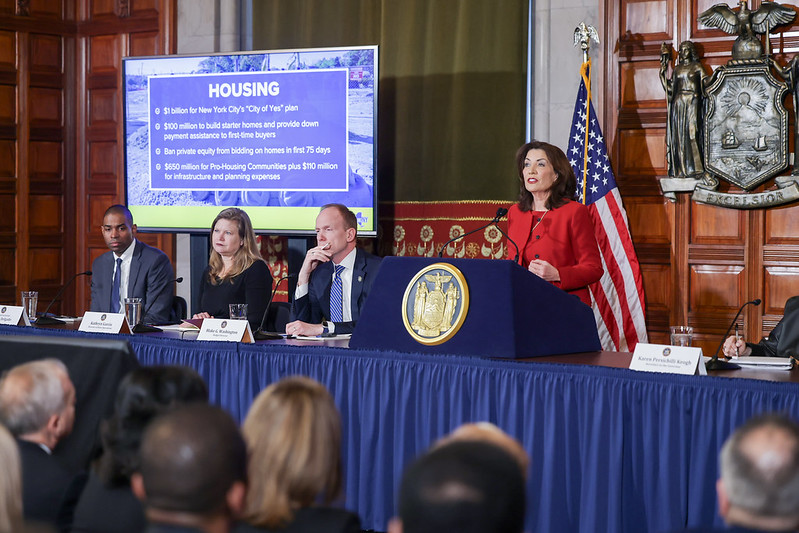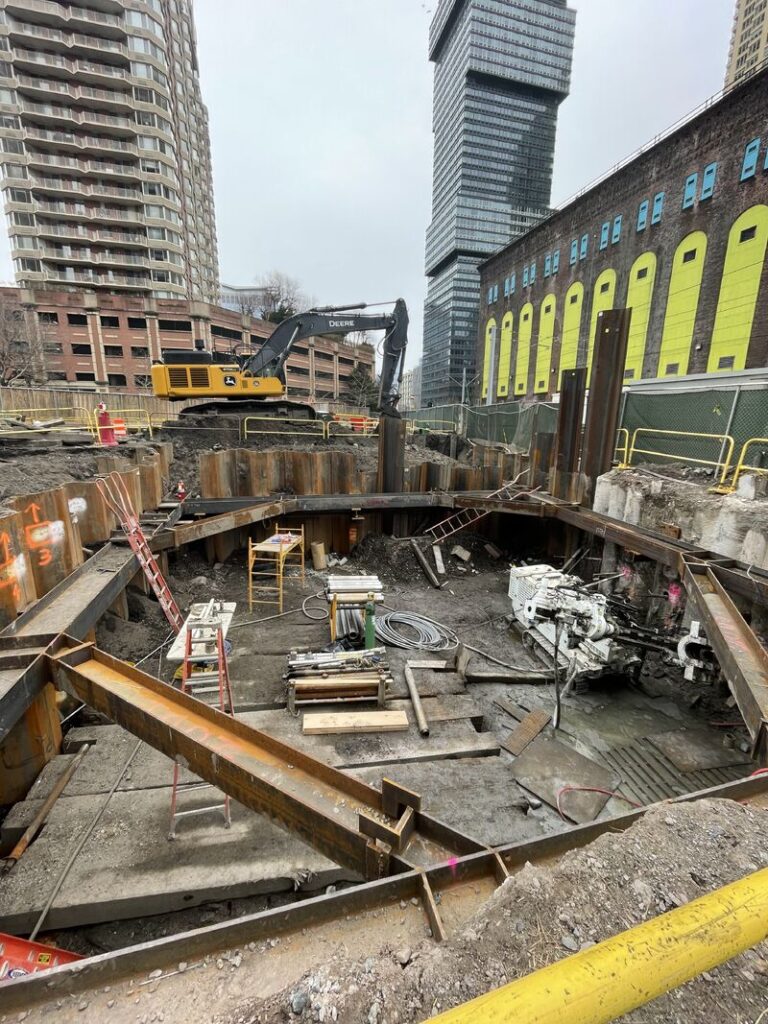Gov. Adds $800M to Budget to Fill Capital Program Gap
ALBANY—It took more than four years of urging from a committed and well-prepared triumvirate of construction executives, organized labor and regional elected officials to finally address the multi-year shortfall in New York State’s capital transportation budget that has been caused erosion of purchasing power from inflation and advancing deterioration.
On Tues., Jan. 21, in her 2026 Executive Budget message, Gov. Kathy Hochul included $800 million in additional funding for roads and bridges statewide. The boost is expected to tackle the backlog of roadway and bridge work, particularly in the Hudson Valley, and it has the support of key leaders in the State Assembly and Senate. Budget negotiations between the Executive Office and the state Legislature will extend through March to meet the start of the new fiscal year on April 1.
A broad statewide coalition of the contracting community, organized labor and transportation advocates, united under the banner of the New York Roadway and Infrastructure Coalition (NYRIC), noted that based on data compiled and reported by the New York State Department of Transportation (NYSDOT), “the system is in a state of substantial decline, and it is imperative that immediate steps are taken to rectify the situation.”

In budget testimony last month, NYRIC officials urged state officials to stop further deterioration of state transportation assests through a three-point recommendation:
- “Acknowledge the Ongoing Inflationary Pressures on the Upcoming Year of the NYSDOT Capital Plan: To counter the unprecedented inflation impacting construction costs, we urge you to support the additional $800 million for ‘core’ projects included in the SFY 2025-26 Executive Budget Proposal.
- “Adopt a formal Twenty-Year Needs Assessment Process for NYSDOT: Based off the structure that best identifies the continuing capital needs of the MTA system, NYSDOT should adopt a similar approach to capturing and addressing future system needs.
- “Adopt a Holistic Approach to Funding the Statewide Transportation System: As new or enhancements to existing revenues are contemplated to close the Metropolitan Transportation Authority’s 2025-2029 Capital Plan gap, ensure that such measures also address the infrastructure needs of NYSDOT.
The governor’s budget failed to provide specifics on how the state will help fund a multi-million funding gap in the Metropolitan Transportation Authority’s capital program.
As a founding member of NYRIC, the Construction Industry Council of Westchester & Hudson Valley, Inc., warned budget planners that by the end of the current historic NYSDOT Capital Plan, New York is projected to have the worst pavement and bridge conditions in decades.
John Cooney, Jr., CIC executive director, was a cosigner on the NYRIC-submitted memo that pointed to key findings from the most recent Annual Highway Pavement and Bridge Conditions Report:
Bridge Conditions
- All 11 NYSDOT regions reported declines in bridge conditions, which is unprecedented.
- An additional 138 bridges have transitioned from good to fair or poor condition, bringing the total number of structures in fair or poor condition—based on federal criteria—to nearly 11,400 or 65%.
- Overall investments in bridge safety assurance declined nearly 20% year-over-year.
Pavement Conditions
- Seven of 11 NYSDOT regions experienced declines in pavement conditions.
- An additional 630 lane miles maintained by NYSDOT have shifted from good to fair and poor condition, raising the statewide total in fair or poor condition to nearly 17,000 lane miles (more than 40%).
- Overall investments in pavement renewal have decreased by more than 31% year-over-year.
Overall Capital Investment
- Total NYSDOT Capital Plan spending declined by nearly $200 million year-over-year.
- Compounding the decline in pavement and bridge conditions, nearly 40% of the $3.3 billion encumbered by NYSDOT from the Capital Plan last year was allocated to activities that did not improve system conditions.
The Budget At-a-Glance
The following are highlights of some of the governor’s $252-Billion 2026 Executive Budget proposals of interest to the construction industry:
Transportation-Roads and Bridges
The Executive Budget provides almost $6.9 billion for the fourth year of a record $34.1 billion, five-year DOT Capital Plan that will facilitate the improvement of highways, bridges, rail, aviation infrastructure, non-MTA transit, and DOT facilities. Compared to the last five-year DOT Capital Plan, this is an increase of $10.7 billion, or 46%. Funding includes $800 million to restore the purchasing power lost to rising construction costs and ensure that planned projects remain on track.
Local Highways and Bridges
Funding for the Consolidated Highway Improvement Program (CHIPS) and the Marchiselli program is maintained at the FY 2025 level of $637.8 million. The budget provides the fourth year of an annual $100 million for the local Pave Our Potholes program, $150 million in highway aid through the PAVE NY program, and $200 million to fund local projects from the BRIDGE NY program. The $100 million Extreme Winter Recovery and $140 million State Touring Route programs are also geared at improving conditions on state and local roads and bridges.

MTA, Hudson Valley Upgrades, Upstate Transit
The governor’s budget calls for $3 billion in state funding to support the MTA’s proposed $68.4 billion 2025-2029 Capital Program. The budget includes $25 million for planning and design of improvements to Hudson Valley rail service, working to shave as much as 15 minutes of commute times for certain trips. A total of $344 million is earmarked for Upstate transit systems and $588 million for non-MTA Downstate transit systems.
Climate Investment
In what has been described as the largest climate investment in New York State’s history, the governor’s 2026 Executive Budget calls for:
- $1 billion for the clean energy transition, including thermal energy networks on State University of New York (SUNY) campuses, retrofitting homes with clean devices like heat pumps, and supporting business decarbonization.
- $500 million for clean water infrastructure that supports municipal drinking water, wastewater treatment and more.
- $125 million for the state Superfund program to remediate hazardous waste, and a 10-year reauthorization of the State Superfund program.
- $108 million to build climate resiliency, including $78 million for coastal resiliency and $30 million in Green Resiliency Grants.
The governor also continues her efforts to combat the housing crisis by earmarking up to $760.5 million for pro-housing communities, $100 million to help first-time homebuyers; and $1 billion to New York City’s ‘City of Yes’ Initiatives.
Inflation Refunds for Taxpayers
In her attempt to foster her affordability agenda, Gov. Kathy Hochul has proposed $5 billion to be put back into the pockets of New Yorkers, The plan includes:
- $3 billion to provide Inflation Refund checks to 8.6 million New Yorkers, including $500 for joint filers making less than $300,000 and $300 for single filers making less than $150,000;
- $1 billion in middle-class tax cuts across five of the State’s nine tax brackets, cutting rates to their lowest level in nearly 70 years for New Yorkers who file jointly and earn up to $323,000 annually;
- $825 million to expand the Child Tax Credit over two years, giving eligible parents $1,000 for kids under 4-years-old;
- $500 for kids ages 4-16 and $340 million to provide free school breakfast and free school lunch for every student in New York.
She is also calling for the full repeal of the SALT deduction, which she noted costs New Yorkers up to $12 billion a year.
Published: February 13, 2025.
